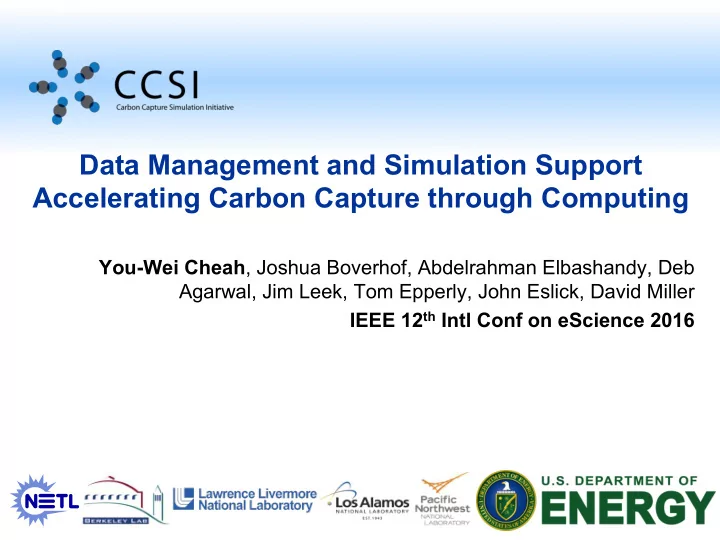

Data Management and Simulation Support Accelerating Carbon Capture through Computing You-Wei Cheah , Joshua Boverhof, Abdelrahman Elbashandy, Deb Agarwal, Jim Leek, Tom Epperly, John Eslick, David Miller IEEE 12 th Intl Conf on eScience 2016
Carbon Capture Challenge Bench Research • The traditional pathway from discovery to ~ 1 kWe commercialization of energy technologies is long 1 , i.e., ~ 20-30 years Small pilot • President’s plan 2 requires that barriers to the < 1 MWe widespread, safe, and cost-effective deployment of CCS be overcome within 10 Medium pilot years 1 – 5 MWe • To help realize the President’s objectives, new approaches are needed for taking concepts Semi-works pilot from lab to power plant, quickly, at low cost and 20-35 MWe with minimal risk • Carbon Capture Simulation Initiative (CCSI) First commercial designed to accelerate the development of CCS plant, 100 MWe technology, from discovery through deployment, with the help of science-based simulations Deployment, >500 MWe, >300 plants 1. International Energy Agency Report: Experience Curves for Energy Technology Policy,” 2000 2. http://www.whitehouse.gov/the-press-office/presidential-memorandum-a-comprehensive-federal-strategy-carbon-capture-and- storage 2
Carbon Capture Simulation Initiative Identify Reduce the time Quantify the technical Stabilize the cost promising for design & risk, to enable reaching during commercial concepts troubleshooting larger scales, earlier deployment National Labs Academia Industry Essential for accelerating commercial deployment 3
CCSI Integrated Process Design Environment Small-scale Particle-scale Process Bench-scale Deployments Simulations Simulations Experiments Uncertainty Quantification, Decision Support, Optimization, etc Knowledge, Information, & Integrated User Environment Decision Makers 4
CCSI Toolset • Comprehensive, integrated suite of validated science- based computational models • Modular design that leverages existing software components • Simulation and data management support provided through CCSI Integration Framework • Components: o Core capabilities for optimization, modeling and uncertainty quantification o Orchestration: FOQUS o Process simulation framework: Turbine, SimSinter, DMF 5
CCSI Toolset Architecture iREVEAL ALAMO Simulation Optimization D-RM Heat Surrogate Surrogate Based UQ Under Builder Integration Models Models Optimization Uncertainty FOQUS FO Framework for Op-miza-on Quan-fica-on of Uncertainty and Sensi-vity Samples Results Meta-flowsheet: Links simulations, parallel execution, heat integration SimSinter Config GUI Turbine SimSinter Simulation Parallel simulation execution Standardized interface for simulation Aspen management system software gPROMS Desktop – Cloud – Cluster Steady state & dynamic Excel Data Management Framework (DMF) 6
FOQUS • Framework for Optimization and Quantification of Uncertainty and Sensitivity • Serves as the primary computational interface in the CCSI Toolset. • Interface to simplify running complex modeling and UQ studies • Modular design involving plugin system • Flowsheet : Composite model, Meta-Flowsheet : Combination of flowsheets • Provides GUI and platform for flowsheet analysis tools • Developed in Python/PyQt/PySide 7
FOQUS: GUI 8
Turbine Science Gateway • Scaling up experiments – Solving large scale simulations (particles, CFD) • Dense phase, reactive flows with complex submodels – Multiple simulation runs (optimization, UQ) • Multiple scales (Particle, Device, System) • Batch system providing staging of input and output files • Generic solution that can be extended to process modeling and simulation packages • Integrated with FOQUS to schedule and scale-up simulation runs 9
Turbine Science Gateway: Components • Designed to operate primarily in Windows • Turbine Web application: – Windows service – RESTful, HTTP API – Five resources in API: Application, Simulation, Job, Consumer, Session – Python library for interfacing with other tools • Turbine Client – Platform independent • Turbine Database – SQLite – Stores state and results • Turbine Server – Executes and manages simulation process through use of SimSinter through Turbine Workers – Multiple workers can be used to form Turbine Cluster 10
Turbine Server Experiences • Framework can be used with single machines, clusters, Cloud computing resources • Scale simulations to allow computations in thousands • Successfully executed 400 instances of Aspen Plus simulations using Amazon EC2 • Harnesses Amazon EC2 spot instances vs owning a cluster of computers • Parallelization increases application throughput and decreases time to solution • Integrated Mass Transfer Model – Local optimization (single processor) 12 hours – Cloud optimization (4-6 consumers) 2.75 hours 11
Recommend
More recommend